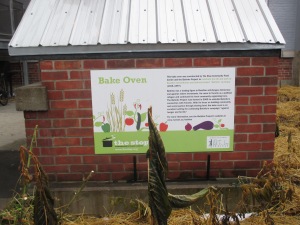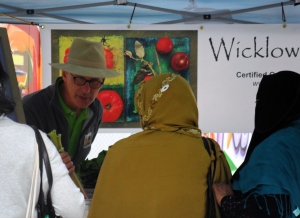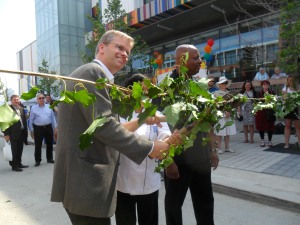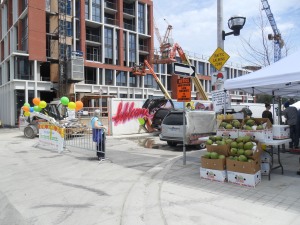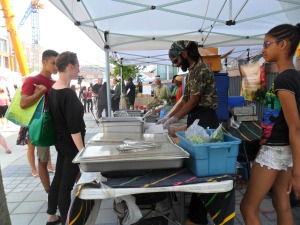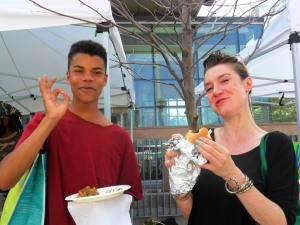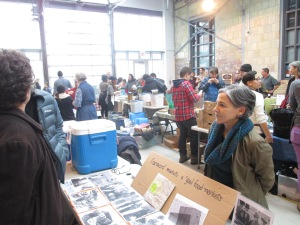“What can be done at the barns to make it a true community hub?” Cookie Roscoe & Teresa Casas
Cookie Roscoe & Teresa Casas
Several weeks ago, I posed this question at the farmers’ market. Naturally enough, people said that it was the market, its vendors, the food, and the experience of community that regularly brought them to the barns. However, some felt that the market was rather socially exclusive because, on average, food costs more than at the grocery store. Without the park users flowing through it they do when it’s outdoors, the indoor winter market felt a little too club-like. They asked, “Couldn’t something be done to attract a wider cross-section of the community here?”
Farmers’ Markets vs. Good Food Markets
In conversation this week, market manager Cookie Roscoe explained that there are two distinct and separate types of markets run by The Stop. One, the Wychwood Farmers’ Market in the Artscape complex, is located in the relatively affluent Ward 21‘s Wychwood area, ranked 65.6 in the City of Toronto’s neighborhood equity scale. It supports sustainable food growing and innovative food-making with local ingredients. The other, known as the Good Food Market, provides fresh produce for low-income community members in the neighboring Ward 17’s southern segment Weston-Pellam Park, ranked 40.47 on the scale. The two markets tackle two different aspects of food security, the former promotes small scale local farming while the latter addresses the dietary needs and social isolation of the under-privileged.
At our Davenport location we offer the Good Food Market. The fresh produce sold there is not produced and sold by local farmers but comes from the food terminal, is local where possible, and is sold at prices lower than those of the grocery-stores.
The Good Food Market is an extension of the food bank program., as is every program The Stop runs. It’s attached to the kitchen programs so anything that’s left over winds up being used in food programming. For example, it might be turned into soup for the hot lunch the next day. In contrast, at our farmers’ market any produce that’s left over at the end of the day winds up going back with the farmers.
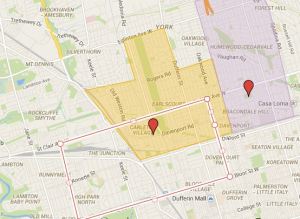 The Stop’s food bank service area
The Stop’s food bank service area
So it’s not donated?
We tried that but the market is on a Saturday and the food bank and the Davenport building itself is closed on Saturdays. And, for example, lettuces unsold at the farmers market would need to be refrigerated until the Monday sorting and the Tuesday food banking, and they’d already be a little old from a day in the market sun… The principle at the food bank is that we don’t serve food that a customer would skip over at Loblaws. The patrons, the consumers at the food bank are you and me, they’re guests at the dinner table. If I wouldn’t eat it myself why would I feed it to my guests?
I know that the bake oven, because it draws people together, is a cornerstone of at the Good Food Market during its outdoor season .
 The Stop’s good food market bake oven
The Stop’s good food market bake oven
Going back to the challenge of the farmers’ market as a community hub, you used the bake oven to bring local residents to the barns before they were developed. Could it again be used to gather the broader community here during the market?
When the complex was built and the park designed around it, the bake oven was removed from the park where the community had built it. It was reconstructed in the Green Barn’s sheltered garden and it’s now The Stop’s responsibility. The organization has not yet found a way to make it accessible to the community. However, it’s the mandate of the Wychwood Barns Community Association and not The Stop to create these sorts of gatherings. So far, this group hasn’t been able to capitalize on the social potential of the bake oven.
Another frequent wish among market shoppers was to have a coffee shop or café, a place that would let people meet in the barns outside of market hours. Barn 2 is empty most days. When it’s not used for events, it looks like an empty airplane hangar. There’s nothing to draw local residents in .
We’re not allowed to have a coffee shop or any form of permanent commercial enterprise. That was added as a last minute codicil at City Council to reassure opponents to the barn’s renovation that it wouldn’t lead to the kind of intense commercial use that attracts trucks and floods of people.
But the farmers’ market, the festivals and fairs every weekend, don’t these count as commercial activity?
As I understand it, the difference is that these are not part of the built-in infrastructure of the barns. Now that the building is operational and we understand it better. It very well might be the time to re-open that and have the codicil removed.
Healing and Education at The Green Barn
I guess farmers’ market visitors are unaware of what happens daily on the other side of the wall in The Stop’s Green Barn?
It’s very ironic. I go into work and the greenhouse is full of really marginalized human beings some of them are new Canadians a lot of them are survivors of the mental health system and the greenhouse is such a healing place. A young man came in today, he’s shaking and he wants to volunteer in the greenhouse because he can see that it’s going to be such a healing place for him. We get people coming in all the time.
However, being in this fish bowl of a greenhouse means that our programs are interrupted by people who come up to the glass and peer in. We might have a classroom full of children doing a workshop… You would never go into Hillcrest School and walk into the middle of a classroom but they do at the barns. They ask, “Is it OK if I go into the greenhouse for a minute?”
Those are people who are using a public park and see the greenhouse as a part of the public space. There are also signs around the Green Barn saying that it’s a place used for interpreting food, culture and the environment.
But we can’t serve everyone. The Stop has a mission, when we move out of the specific terms of reference for programs we would no longer be fulfilling our mandate. We’re critically tied to providing a core set of programs. We serve the unseen people within this community that nobody cares about or would know about.
The Lessons of the Regent Park Farmers’ Market
Can you create a market that supports farmers as well as providing the benefits of the Good Food Market? That was the issue we explored in launching the Regent Park Farmers Market the summer of 2013.
Of course, the farmers market that you and I and Peter McCluskey set up still exists nominally but it’s taken a different direction. What I feel the Daniels Corporation, which set the market in motion, didn’t understand was that if the farmers market were run properly and allowed to properly flourish, it will eventually be a multi-faceted community jewel that everybody in the neighborhood will be invested in. But we must start from ground zero: Is it good for Ontario agriculture? Will it serve farmers well? If it serves farmers it can grow into anything you want it to become, but if it does not serve Ontario farmers or agriculture well then it will fall apart, the centre can’t hold.
Created in partnership with Toronto Community Housing as part of the Regent Park Revitalization Plan, The Daniels Corporation launched the farmers market as a key program at the Daniel’s Spectrum. The market was to celebrate food, culture and well-being and to bridge the gulf between the established low-income community and the arriving mid to high-income condominium residents. To do this, you were asked to bring those two models, the Good Food Market and the farmers market, together in one.
The urban farmers were aware that the area was a food desert and were very interested in serving low-income and culturally diverse consumers not typically found in other markets. It was generating a lot of interest. We built a market of roof top gardeners, pedal powered gardeners, local youth gardeners. We had a couple of guys bringing Samsonite suitcases on the Go Train from the one acre they were camping on. It was priceless—the amalgam of vendors we put together there was truly exquisite.
 Amy Cheng, Red Pocket Farm
Amy Cheng, Red Pocket Farm
 Fathima’s Kitchen: Daniel’s Spectrum’s Paintbox Bistro offered kitchen time and mentoring to local chefs who wanted to launch small scale catering businesses
Fathima’s Kitchen: Daniel’s Spectrum’s Paintbox Bistro offered kitchen time and mentoring to local chefs who wanted to launch small scale catering businesses
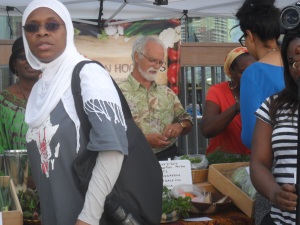 Robert & Veronica, Southern Horizons
Robert & Veronica, Southern Horizons
The problem was that all market stakeholders, not only Daniels but the local social service agencies and community members, were insistent that the produce at the market had to be cheap. I explained repeatedly that the farmers themselves set the prices. I was ignored.
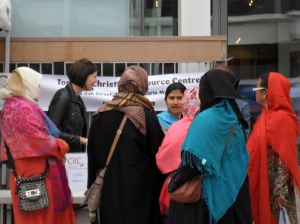 Christian Resource Centre market stall
Christian Resource Centre market stall
We tried to explore ways that local gardeners could be involved in the market, getting Regent Park to feed Regent Park, but no leads were followed as soon as obstacles were perceived.
 Regent Park City of Toronto Community Housing allotment gardens where many residents grow salad greens and vegetables.
Regent Park City of Toronto Community Housing allotment gardens where many residents grow salad greens and vegetables.
The market was fed to the media as another shiny new thing in Regent Park and ignored was the deeper story of the farmer vendors.
To add to this, instead of sending out $5 vouchers to area residents as a way of drawing in everyone, staff chose to hand-out $2 and $3 vouchers selectively at the entrance. It was as bad for the market as anything could possibly have been.
Never mind that we were in a cement alley with dirt and gravel blowing through from the surrounding construction sites, this was an admission to the community that the food was going to be tough for some people to afford, and every time they came they could have a little freebie. Degrading, more to the farmers than to the chosen people who got the vouchers worth exactly the cost of the offerings from the local cooks with no market produce in these dishes or snacks. In this way the “promotion” of the market perfectly subverted the intent of the market.
Regent Park residents would compare the farmers’ market prices to those of the local retailers, notably a Fresh Co. which stocked a wide selection of South Asian produce and “Wali” the local green-grocer in his pop-up trailer market.
One of the conditions set by Daniels when we came in was, “You can’t mess with Wali.” It was veryquickly apparent to me that Wali was not getting his stuff from all the normal places. The culturally sensitive stuff he was selling, the manioc, coconut etc. he was getting as high a quality as could be gotten. The rest of it was a mystery, I suspect it was loads that were rejected for sale at grocery stores. I saw $8 bags of organic fingerling potatoes for sale in his store for $1, which is hard to explain. When ten or twenty percent of a load is testing bad, it’s kicked but eighty to ninety percent is just fine. I would, if it were legal to do so, pick through and eat it and I would serve it to my guests. He was buying very cheaply and selling very cheaply and keeping his customers fed in exactly the way they wanted. Provided he was carefully selling only the ok percentage parts, I think it was a clever way to provide people with cheap food. By insisting I allow “cheap” food into the farmers market, the people doing the insisting were forcing me to build an entity that would compete with Wali, something I’d been given directions to not do. Whether what he was doing was strictly legal or not, it would be a very shabby thing in my opinion to compete with him on an uneven playing field artificially constructed for the purpose of continuing to deny what food actually costs.
I also remember older Regent Park residents walking by the market and sneeringly commenting that is was a sign that the “yuppies” had moved in. The reaction against the farmers’ market as a symbol of Regent Park’s gentrification was seen in the Comments to a feature on the market in a Toronto e-zine blogTO.
How would the Regent’s Park farmers’ market have worked in an ideal scenario? Walk me through how you expected someone in the neighborhood to use the market.
They would come in off the street, and think, ‘Well what have we got here!’ And they would look to both sides and they would see produce and Zach would be there wolf-whistling at them and telling them to try a cucumber and they would shy away and then enter and at the far end they would be teased by the sights and smells of culturally familiar food being served. And they would go down, get a plate of rice and beans and samosas or something in a kati roll, saunter through the market with a two or three dollar offering of a meal and they would be accosted by a chef who looks like them and who would say, “Look at what I got at the market today, here’s how I cooked it.”
There’s music playing and there’s children playing and there’s a wide variety of people there and the people who are the new neighbors who are moving into the condo towers around them are likewise coming and saying, “What have we got here?” And they’re bumping elbows with each other and they’re learning about cooking at the same time as the long-time residents, maybe they already know how to cook this stuff. “What do you call this vegetable?” Everybody’s got a recipe, “I cook it that way.” “I make soup.” “I would never have thought to do that!” “You need to buy some of her meat to put in that soup because that would be fabulous!” It’s just everybody talking. I’ve seen it happen a million times because it’s what happens every week at the Wychwood Barns.
market square discussion:
Are The Stop’s Farmers’ Market and Good Food Market mutually exclusive models for community food hubs? If so, what are the consequences of this?
This is the second of a two part post. To see the first click here.




